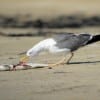 By Jim Stevenson,
By Jim Stevenson,
1. There will be no field trip this coming Saturday, as I will be volunteering to help with species assessment on some new sanctuary land on Galveston.
2. Please be mailing me your checks for calendars, books, etc., received. I am also mailing out more today, and the cost will be just under the return address at the top left.
3. As I approach my 20th year in this capacity, this week you will receive the opportunity to critique all phases of my job as Director of the GOS – the first after 19 years! Participation is totally up to you, and it will be structured to take very little time. Only I will read it but suggestions are welcomed on all aspects of the GOS.
4. Also…you will begin receiving information on upcoming trips – some brand new – so you may make more informed decisions about participation. No response required, unless you are interested.
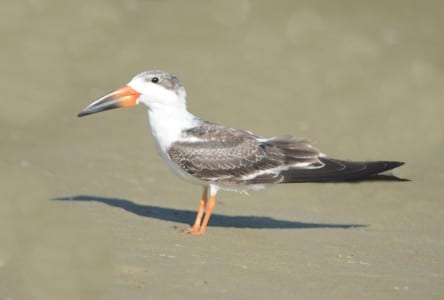
This young Black Skimmer is stuck in juvenile plumage, and had no adults around anywhere to bug. Notice how quick they are to gain their black bill tip and full size. These juvenile colors work much better for hiding on the beach while mom and dad bring food, but now it’s time for a black back. This is one of four species of skimmers Worldwide, and the only one in the Americas. This might be a good time to mention that many shorebird species know, like curlews, godwits, stilts, avocets, oystercatchers and many more are actually part of a small group, with only one found in our area. It is possible to go to other continents of the Old World and see other kinds.
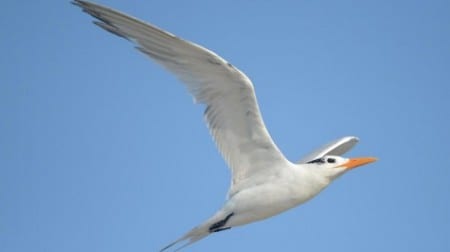
See what I mean? Royal’s beak is more slender and not as red. Also, they are a more slender bird with a long, forked tail. Royals are built for longer distance flight as they usually feed miles out in the Gulf. In spring, it is really cool seeing what kinds of godawful fish they catch and bring to their young on shore. Notice, of course, their winter plumage, lacking the dark forehead.
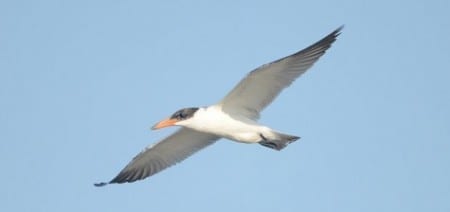
A tern wouldn’t know what to do with a fish on the beach, but they do know how to get their own. This young Caspian Tern is learning the beach and where fish like schooling mullet are found. This species and the Royal continues to beg for food many months after they are full grown, but their parents largely ignore their whining. The bill is not only redder than Royal, it’s thicker.
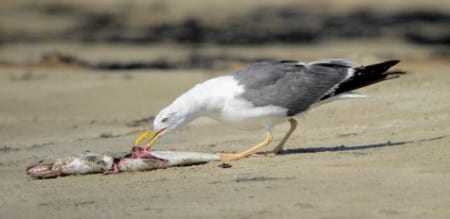
Ecology changes at times, and since the arrival of the Lesser Black-backed Gull, August and September no longer belong to the Ring-billed Gulls before the Herring arrives. LBBGs are larger and they really dominate the treats on the beach like this jack (I think). They’ve been in America for a half-century or so and seem to be carving out a niche as time goes on.
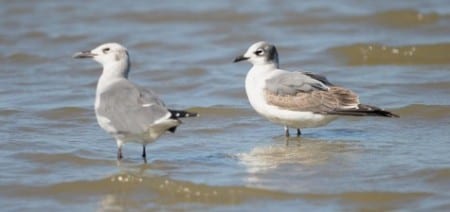
The second half of the fall migration allows us to see Franklin’s Gulls as they try to sneak thru undetected in massive flocks of Laughing Gulls. They are most easily picked out by the dark back of the head, but the bill is smaller, they have a more rounded head, and they tend to stand shorter than Laughing Gulls. They also have a bad habit of standing at the back of many gull flocks, making them hard to find with their low stature.
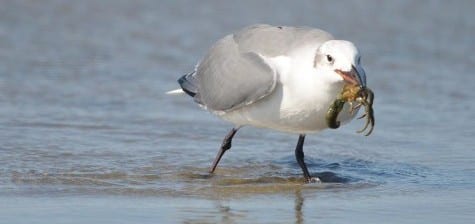
This is a winter-plumaged Laughing Gull, but what is in his mouth?!? Well, it’s a hermit crab, pulled out of its gastropod shell in which it lived. The left side hooks into the gastropod’s empty shell and is normally never exposed. This poor crab is toast, as it has no defense against the marauding gull. We had a sudden low tide with a wind shift & there were hermit crabs all over the place, like the one on the left. They occupy leftover gastropod (marine snail) shells like lightning whelks, pear whelks, fighting conchs and Lawrence Whelk.
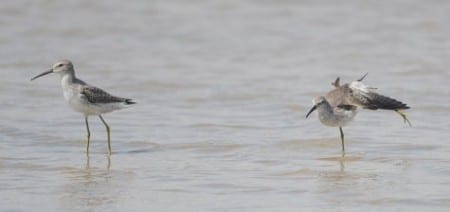
These are medium-sized members of their family called Stilt Sandpipers. They have longish beaks that droop slightly and quite long legs for sandpipers. Curiously, they do winter in Brazoria County in small numbers, although their fall and winter plumage is not quite as nice as the breeding colors we see in the late April birds that drop in. Don’t forget their supercilium.
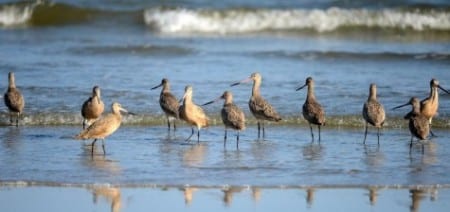
Like curlews, there are several species of godwits around the World, and the Marbled breeds and will winter in America. Many shorebirds have black tips on their beaks so the melanin stiffens the bill and allows them to roughhouse without cracking the end of the beak. This flock of godwits is likely a group heading further south to winter, and some do make it to South America.
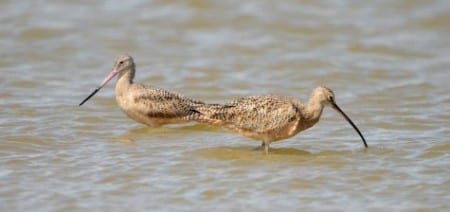
Our two largest sandpipers are the Marbled Godwit (left) and Long-billed Curlew (right). They have rather similar feeding styles in the water, where they wade deeper than other ‘pipers and probe for worms and other morsels. However, curlews roam the shores looking for fiddler crabs, which they are able to pull up out of their burrows with the long bills.
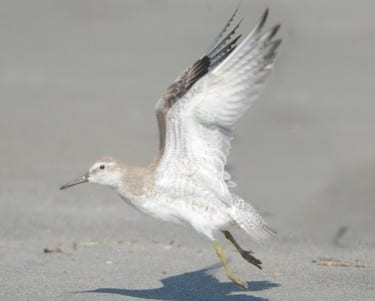
Sandpipers like this Red Knot have great flying ability and many fly thousands of miles from their Arctic breeding grounds. Many stop along the New England Coast to feed on horseshoe crab larvae, and the overharvesting of them for lobster bait has diminished knot numbers severely. In late April, these and several other sandpipers (and two plovers) attain wonderful breeding colors.
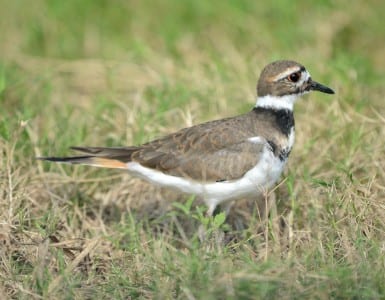
Killdeer are plovers with similar bills, but slimmer builds. How poetic. They stand alone in the shorebird world with two rings, but males should have more since they are polygynous. Killdeer do breed on the Texas Coast in small numbers but many more winter residents roar in mid fall, flying “up” the coast (NE) on mornings with good flight conditions.
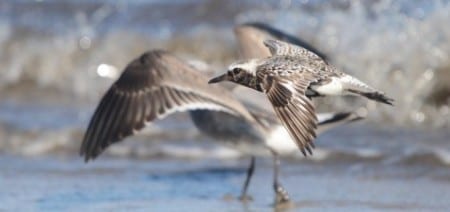
Shorebirding is often crowded, with many species flocking together. This is a Black-bellied Plover sailing past a Laughing Gull, showing some of the size disparity in their order. Neither bird represents extremes in charadriiform sizes, either. This plover is a long-distance migrant and you can see it’s built for speed and many hours of flight. Note the short, plover bill for beach combing.
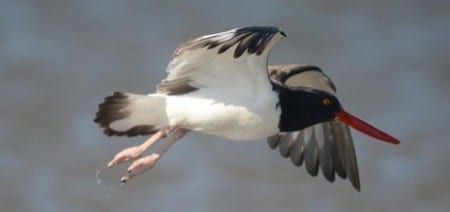
The pink legs and feet of the oystercatchers have extremely thick skin, allowing them to walk on oyster shells without getting a booboo. Their primaries are dark, like most charadriiforms, cutting down on feather wear throughout the year. They also have among the broadest wings of any charadriiform as their heavy body requires that, and most shorebirds are very long-distance migrants.
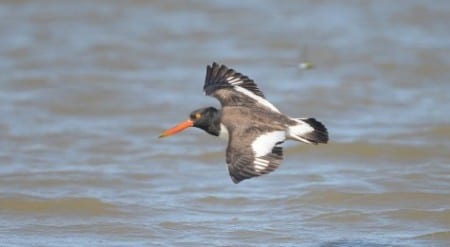
Many shorebirds have white lines down their wings that act as flash colors, causing predators like falcons to grab at their expendable flight feathers rather than the potential prey’s body. Oystercatchers are probably the heaviest of the shorebirds and the least swift on the wing. They have very little long-distance flying so they are modest fliers.
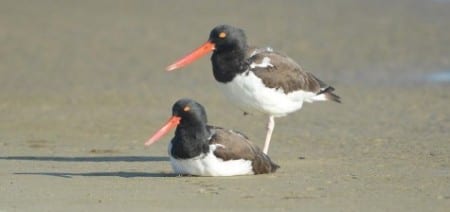
American Oystercatchers breed in Galveston Bay and some pairs remain together in the offseason. They nest on small islands on the Bay and old concrete ships! 😉 Oystercatchers like these with white bellies are adapted for sandy beaches while those which are all dark are on rocky shores, like along the Pacific Coast. It is their knife-like bill that allows them to open bivalves by cutting the adductor muscle.
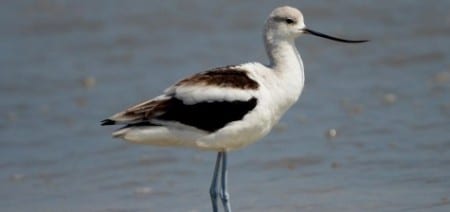
One of the oddballs is the avocet, with one species found here in North America. This is the American Avocet, and the winter plumage they arrive in lacks the beige head and neck they’ll develop by late March. This is the female, with the more recurved beak. Their cobalt-blue legs are a year-round phenomenon, not unlike the color of breeding Reddish Egrets.
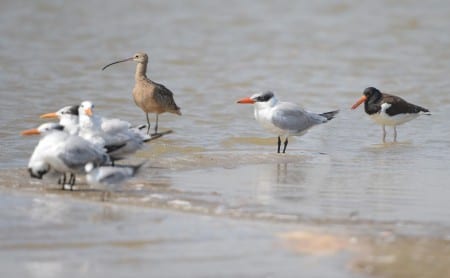
Of the 27 orders of birds, the one that surely has the most disparity (many dissimilar forms) is the huge assemblage called Charadriiformes. They have terns (see the Caspian, Common and several Royals), sandpipers (see the largest, the Long-billed Curlew), plovers and other shorebird oddballs like the oystercatcher on the right, gulls and skimmers. Most are adept at making a living along the shores.

 Posted in
Posted in 























